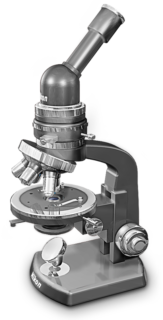Nikon’s Museum of Microscopy
Model S-Po Microscope
( Circa 1971 )
The model S-Po was a specialized version of the model S microscope, manufactured in the early 1970s, that came equipped with a polarizer unit, analyzer unit, "polarized" eyepiece, and a graduated circular rotatable stage. Depending on the user's needs, the microscope could be equipped with various combinations of eyepieces, eyepiece tubes, objectives, condensers, and stages.

The removable polarizer unit is positioned beneath the stage and consists of a condenser, an iris diaphragm, a rotatable sheet polarizer, and a filter case beneath the polarizer. A daylight filter placed in the filter case eliminated the reddish hues of incandescent lighting, creating a broader daylight spectrum and was used to make cleaner color polarized light observations. Focus was accomplished with a concentric set of fine and coarse adjustments that moved the stage in relation to the microscope stand. Another knurled knob served to translate the substage condenser upward and downward with respect to the stage. Specimens were secured to the stage with a pair of stage clips.
The analyzer, composed of an analyzer and a detector, incorporates a sheet polarizer, which can be rotated to within six minutes of a degree with a calibrated vernier scale. When the microscope wasn't being used with polarized light, the analyzer unit, which was housed in an intermediate tube, could be removed from the optical path. A Bertrand lens was also provided for conoscopic observations using the higher power objectives.
The circular stage could rotate a full 360°, adjustable to within 6 minutes of a degree, and was locked by a clamp screw. Centering screws brought the optical axis of the microscope objectives into alignment with the center of the rotating stage. A test plate, used for detecting the optical axes as well as double refraction of crystalline substances, was provided as an accessory. This add-on consisted of a quarter-wave plate and a 530-nanometer first-order retardation plate.
A two-sided reflecting mirror provided illumination for the basic microscope model. One side of the mirror had a plane surface, which was used with the condenser. The other side had a concave surface, which was used without the condenser when employing an objective with a magnification of 20X or less. Illumination could be provided by an ordinary 60-watt light bulb, with a daylight filter in place, or by the Köhler method with a Nikon universal microscope lamp. Nikon also manufactured a small 15-watt substage lamp that was available as a replacement for the mirror.
Today Nikon offers a number of upright polarized light microscopes.













